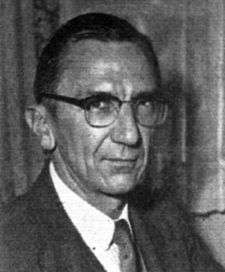Ed Heinemann
| Edward Henry Heinemann | |
|---|---|
 | |
| Born |
March 14, 1908 Saginaw, Michigan |
| Died | November 26, 1991 (aged 83) |
| Occupation | Aeronautical engineer |
Edward Henry Heinemann, (March 14, 1908 – November 26, 1991) was a noted military aircraft designer for the Douglas Aircraft Company.
Biography
Heinemann was born in Saginaw, Michigan, but moved to California as a boy and was raised in Los Angeles. A self-taught engineer, he joined Douglas Aircraft as a draftsman in 1926, but was laid off within a year. After stints at International Aircraft, Moreland Aircraft, and the first Northrop Corporation, Heinemann rejoined Douglas when it acquired Northrop. Heinemann became Douglas's Chief Engineer in 1936. He remained with the company through 1960, when he left to join Guidance Technology. In 1962 he joined General Dynamics as Corporate Vice President of Engineering. In this position he oversaw the development of the F-16. He retired in 1973.
His approach to aircraft design was uncomplicated, once saying that he simply took the most powerful engine available and designed the aircraft around it.
Designs
During his long career at Douglas, Heinemann designed more than 20 combat aircraft, primarily for the U.S. Navy, including many that became legends in aviation history. His designs included the following aircraft:
- SBD Dauntless dive bomber
- A-20 Havoc light bomber/attack aircraft
- A-26 Invader light bomber/attack aircraft
- A-1 Skyraider attack aircraft
- A-3 Skywarrior bomber[1]
- A-4 Skyhawk light bomber
- F3D Skyknight night fighter
- F4D Skyray carrier-based fighter aircraft
- Douglas Skystreak and Douglas Skyrocket research aircraft
One of the first aircraft to be designed by Heinemann was the Moreland M-1 Trainer of 1929, a braced-wing parasol wing monoplane. Due to the 1929 recession only a small number were sold before the company ceased trading in 1933.[2]
Awards and medals
- 1953: Collier Trophy (for the F4D Skyray)
- 1978: Guggenheim Medal
- 1981: National Aviation Hall of Fame
- 1983: National Medal of Science
The Naval Air Systems Command awards the "Edward H. Heinemann Award" annually to the individual or group that makes a significant contribution to aircraft design.
References
External links
- Heinemann biography at Skyhawk Association site
- The Illustrated Encyclopedia of Aircraft (Part Work 1982-1985). Orbis Publishing. 1985.
- Edward H. Heinemann and Rosario Rausa, "Ed Heinemann - Combat Aircraft Designer", ISBN 0-87021-797-6
- Edward Henry Heinemann Personal Papers, San Diego Air and Space Museum Library and Archives
- Edward Henry Heinemann (Photo Collection), Flickr, San Diego Air and Space Museum Archives